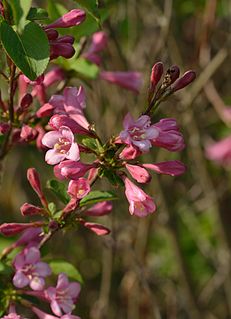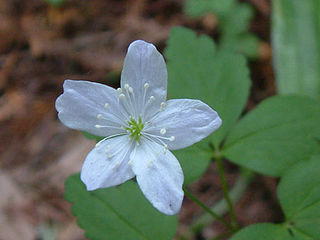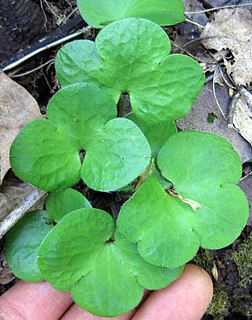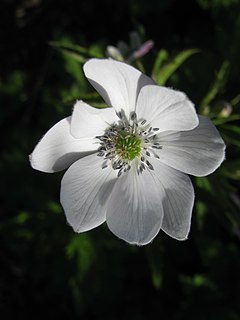
Anemone is a genus of flowering plants in the buttercup family Ranunculaceae. Plants of the genus are commonly called windflowers. They are native to the temperate and subtropical regions of all continents except Australia and Antarctica. The genus is closely related to several other genera including Anemonoides, Anemonastrum, Hepatica, and Pulsatilla. Some botanists include these genera within Anemone.

Elaeagnus, silverberry or oleaster, is a genus of about 50–70 species of flowering plants in the family Elaeagnaceae.

Weigela is a genus of between six and 38 species of deciduous shrubs in the family Caprifoliaceae, growing to 1–5 m (3–15′) tall. All are natives of eastern Asia. The genus is named after the German scientist Christian Ehrenfried Weigel.

Anemonoides quinquefolia, a flowering plant in the buttercup family Ranunculaceae, is native to North America. It is commonly called wood anemone or windflower, not to be confused with Anemonoides nemorosa, a closely related European species also known by these common names. The specific epithet quinquefolia means "five-leaved", which is a misnomer since each leaf has just three leaflets. A plant typically has a single, small white flower with 5 sepals.

Anemone hepatica, the common hepatica, liverwort, kidneywort, or pennywort, is a species of flowering plant in the buttercup family Ranunculaceae, native to woodland in temperate regions of the Northern Hemisphere. This herbaceous perennial grows from a rhizome.

Symphyotrichum lateriflorum is a species of flowering plant of the aster family (Asteraceae) native to eastern and central North America. Commonly known as calico aster, starved aster, and white woodland aster, it is a perennial, herbaceous plant that may reach 120 centimeters high and 30 centimeters across. Each flower head has many tiny florets put together into what appear as one.

Pulsatilla patens is a species of flowering plant in the family Ranunculaceae, native to Europe, Russia, Mongolia, and China. Common names include Eastern pasqueflower and cutleaf anemone.

Hepatica americana, the round-lobed hepatica, is a herbaceous flowering plant in the buttercup family Ranunculaceae. It is native to the eastern United States and Canada.

Acmispon dendroideus, synonym Syrmatium veatchii, is a species of legume native to California. It is known by the common name island broom. It is endemic to the Channel Islands of California, where it grows on coastal bluffs and cliffs. It is a spreading perennial herb or erect shrub approaching 2 meters in height. It is hairless to hairy and gray-green in color. The branches lined with leaves each made up of a few oval leaflike leaflets up to 1.5 centimeters long each. The inflorescence bears up to 10 yellow pealike flowers, each roughly a centimeter long and fading red as they age.

Eriocapitella hupehensis, a species of flowering plant in the buttercup family Ranunculaceae, is native to Asia. The specific epithet hupehensis, which means "from Hupeh province, China", refers to a region where the species is known to occur. In Chinese, it is called da po wan hua hua, which means "broken bowl flower".

Lumnitzera is an Indo-West Pacific mangrove genus in the family Combretaceae. An English common name is black mangrove. Lumnitzera, named after the German botanist, Stephan Lumnitzer (1750-1806), occurs in mangroves from East Africa to the Western Pacific, and northern Australia.

Eriocapitella rivularis, a species of flowering plant in the buttercup family Ranunculaceae, is native to Asia. The specific epithet rivularis means "waterside, of the rivers", which evidently refers to one of its preferred habitats. It is commonly called the riverside windflower. In Chinese, it is called cao yu mei, which means "grass jade plum".

Hepatica acutiloba, the sharp-lobed hepatica, is a herbaceous flowering plant in the buttercup family Ranunculaceae. It is sometimes considered part of the genus Anemone, as Anemone acutiloba, A. hepatica, or A. nobilis.

Eriocapitella is a genus of flowering plants in the buttercup family Ranunculaceae. Plants of the genus are native to Asia. The generic name Eriocapitella roughly translates to "growing in a small woolly head", which refers to the hairy ovary and fruit of some members of the genus. Cultivated plants are commonly known as fall-blooming anemones.
Eriocapitella vitifolia, a species of flowering plant in the buttercup family Ranunculaceae, is native to Asia. The specific epithet vitifolia means "vine-leaved, with leaves resembling those of Vitis", the genus of grapevines, and so the plant is commonly called the grape-leaved anemone or grape-leaved windflower. In Chinese, a common name is ye mian hua, which means "wild cotton".
Eriocapitella tomentosa, a species of flowering plant in the buttercup family Ranunculaceae, is native to Asia. The specific epithet tomentosa means "thickly matted with hairs, tomentum (padding)". In Chinese, a common name is da huo cao, which means "fire grass" or "fireweed".
Eriocapitella japonica is a species of flowering plant in the buttercup family Ranunculaceae. The specific epithet japonica means "from Japan", which is a misnomer since the species is introduced in Japan. It is native to China, Taiwan, and Vietnam.

Eriocapitella × hybrida is a hybrid of flowering plants in the buttercup family Ranunculaceae. The parents of the hybrid are E. japonica and E. vitifolia. Cultivars of the hybrid are commonly known as Japanese anemone hybrids.
Elaeocarpus stipularis is a tree in the Elaeocarpaceae family. It is found from the Aru Islands, eastern Indonesia, to Philippines, and through Mainland Southeast Asia to Odisha, India. It has edible fruit, its wood is used and some medical uses are ascribed to it.

Hepatica transsilvanica, called the large blue hepatica, is a species of flowering plant in the genus Hepatica, native to the Carpathian Mountains of Romania. It has gained the Royal Horticultural Society's Award of Garden Merit.





















